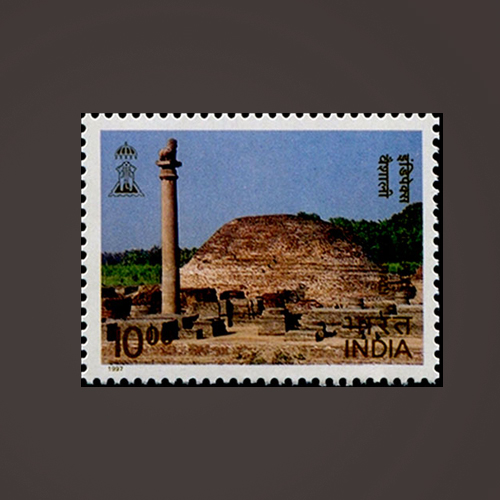Fascinating Archaeological Facts on Postage Stamps - 51
2025-06-23 Mon
Vaishali is a historically significant city located near #Patna in #Bihar. This ancient #city is referenced in several important texts, including the Rig Veda, the Ramayana, Buddhist and #Jain literature, and the Puranas. The Ramayana describes #King Vishala, who is credited with founding the city known as Vishala Puri. Notably, Buddhist #tradition states that Siddhartha Gautama, known as the #Buddha, delivered his last sermon in Vaishali. The Second Buddhist Council also took place in this city.Furthermore, it is believed that Jain Tirthankar Mahavira was born in Kundagram, near Vaishali. The Chinese traveler Fa-Hien documented his visit to Vaishali in the early 5th century CE, highlighting the presence of stupas and monasteries.
Vaishali served as the capital of the republican Licchavis. The Relic Stupa of Vaishali was constructed by a Licchavi king to contain relics of the Buddha. The Mahaparinibbana Sutta mentions that the Licchavis of Vaishali were among the groups designated to receive a portion of the Buddha's cremated remains.
The Ashokan Pillar in Kolhua is constructed of red sandstone and topped with a lion. Erected in the 3rd century BCE, the pillar features symbols of the lotus and the Lion, which are significant in relation to Ashoka's sovereignty and Buddhist iconography. The lotus is representative of purity, while the lion embodies the Buddha, often referred to as Shakyasimha ("the lion of the Shakya clan").
The Ashokan pillars were known as Dhamma Sthambha. The term Dhamma Sthambha likely refers to a pillar associated with Dhamma, most commonly linked to Ashoka’s Pillars. These were physical structures erected by Emperor #ashoka (circa 268–232 BCE) to propagate his interpretation of Dhamma, a code of conduct rooted in Buddhist principles but adapted as a universal ethical framework. Ashoka’s Dhamma emphasized non-violence (ahimsa), truthfulness, compassion, and respect for all religions. His pillars, such as the #Sarnath Pillar with its Lion Capital, served as public declarations of these ideals, inscribed with edicts to guide his subjects.
The Sarnath Pillar, for instance, is a famous Dhamma Sthambha, symbolizing the Buddha’s first sermon, the Dhammacakkappavattana Sutta (Setting in Motion the Wheel of Dhamma), delivered at Sarnath. The pillar’s Lion Capital is now #India's national emblem. For more insights refer to This Post
Due to its historical connections with prominent religious figures, Vaishali has established itself as a significant center for spiritualism and ascetic practices. It is strategically situated along the ancient royal road connecting Pataliputra to #Lumbini. Archaeological excavations conducted by the #ArchaeologicalSurveyofIndia (ASI) have uncovered ancient artifacts dating from the Northern Black Polished Ware (NBPW) period to the Post-Gupta period within the Vaishali region.
In addition, the fourth and final stamp issued by India Post in commemoration of the 'INDEPEX-97' international Stamp Exhibition features both a Stupa and an Ashoka Pillar. For more information regarding previous stamp issues, please consult :
This Post
This Post
This Post
Latest News
-
Science and Technology on Indian Postage Stamps-6
2025-11-12 WedSir Mokshagundam Visvesvaraya is regarded as one of India's most distinguished engineers. His innova...
-
Science and Technology on Indian Postage Stamps-5
2025-11-11 TueSir Jagadish Chandra Bose recognized as India's first biophysicist was born on 30 November 1858, in ...
-
'Al-Sultan' Type Copper Double Falus of Malwa Sultan Ghiyath Shah
2025-11-07 FriAnother type of Copper Double Falus of Malwa Sultan Ghiyath Shah, weighing 17.5-18.1g. <br><br> I...
-
Science and Technology on Indian Postage Stamps-4
2025-11-07 FriThe last stamp in the series issued by India Post on 11 September 1997, to commemorate the 50th anni...
-
Science and Technology on Indian Postage Stamps-3
2025-11-06 ThuThe next #stamp in the series issued by #India #post on 11 #September 1997 commemorates the 50th an...

